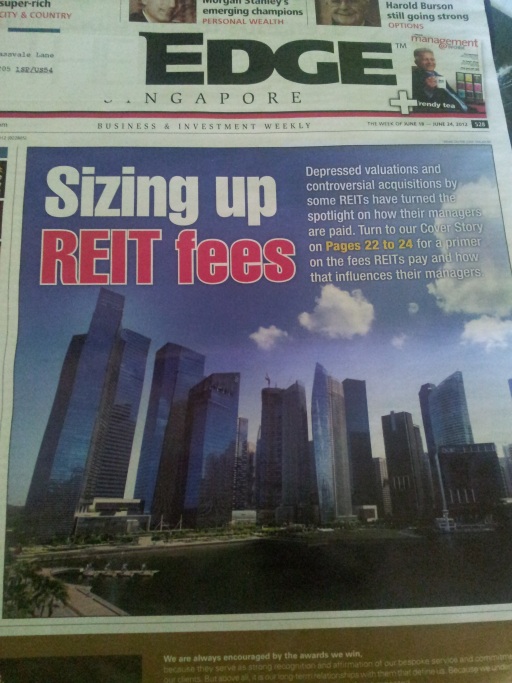
The chatter since the KREIT debacle was that the management structure of Singapore Real Estate Investment Trust (REIT) are under close scrutiny. Are they working for themselves or working for you the shareholder?
For those interested in investing in REITs they may want to pick up a copy of The Edge ($3.00) whose cover story is on this issue. There are quite a few articles on Food Empire, Olam and MRO companies like ST Engineering and SIA Engineering.
Here are some key points from the article
Some of the past history of REIT misbehavior:
- Some REITs do not pay enough attention to their funding as they pursued asset growth
- MacArthurCook Industrial REIT (Aims Amp Industrial REIT) committed itself to acquiring an industrial property but couldn’t pay up
- K-REIT Asia, Mapletree Logistics Trust, Frasers Commercial Trust turned to their respective parents for financial support
- Capitamall Trust, the largest REIT in Singapore, tapped investors for $1.23 billion via a deeply discounted rights issue
- 2011, KREIT Asia bought an 87% stake in Ocean Financial Centre from Keppel Land for $2.013 billion. The asset was not immediately yield-accretive, Keppel Land agreed to provide “Income Support” of $170 mil over 5 years to the REIT. To fund the purchase, a discounted rights issue to raise $983 mil was carried out
A Standard Chartered Report pointed out that most REITs in Singapore are trading at discounts to their net asset values, and sport yields that are exceptionally high, reflecting broad concerns with the way they are managed.
Layers of fees:
- Managers don’t just get a single base fee to cover every thing they do
- Many layers of fees on top of base fees
- Why do some REIT managers charge project management fees while others do not
- Analysts and some industry players say a structure that rewards boosting revenue, promote acquisitions
- Analyst say that the performance fees should be pegged to share price and dividend per share performance
- Cambridge and Starhill Global pegged their performance fees to their relative performance of their shares versus some benchmark
- Ascendas REIT and Aims Amp link their performance fees to the growth of their dividend per share (DPU)
- The overall fee structure of REITs promotes asset growth bias. Since base fee, which is usually the largest fee component, depends on a percentage of AUMs, the larger the AUMs the higher the fees
The best management talent in the business is typically found within large property groups such as Capitaland, Ascendas and Mapletree
I hope I am reading the table right because it seems that K-REIT Asia,Frasers Commercial Trust and Suntec REIT have huge management fee as % of their net income. I hope its not distorted.
To follow the dividend yield changes daily as well as the valuation changes, you can follow my Dividend Stock Tracker which is updated daily.
- My Dividend Experience Investing in UCITS iShares iBond Maturing in 2028. - April 23, 2024
- We Invest into Popular Funds When They Are Popular, Exactly When They Started Turning to Shxt. - April 22, 2024
- Meal Prep 2.0 – Cooking Your “Go-to” Meal that You Look Forward to Eating Everyday. - April 21, 2024


Drizzt
Friday 15th of June 2012
i suspect that perhaps it is due to the earnings only reflecting part of income. but if they are not earning those income then they shouldnt be earning those nominal fees. or they are just expensive.
James
Friday 15th of June 2012
Hi, thanks for sharing this article. Do you mind sharing the subsequent data table 'What REIT unitholders pay to their managers' too? Thanks!
The management fee as % of Revenue differs significantly from % of Net Income. Could it be caused by gearing of the REIT, thus increasing the interest payments?
On a side note, KREIT management fee is really expensive, management fee as % of revenue and net income are both 30%!